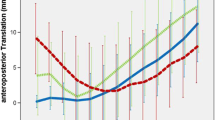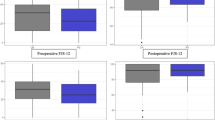Abstract
Introduction
This study compared joint line changes and functional outcomes between cruciate-retaining (CR) and posterior-stabilized (PS) computer-navigated total knee arthroplasties (TKAs). With the increased precision offered by computer navigation, we hypothesized that there should be minimal differences in the joint line changes between the groups and thus no significant differences in the clinical outcomes.
Materials and methods
A retrospective study of 195 patients with a minimum of 2-year follow-up following primary surgery was conducted. The patients were stratified into two groups: the CR group and the PS group. The joint line changes of both groups were then compared using the Student t test. Multivariate analysis and regression modelling were then utilized to analyze the functional outcomes of both groups.
Results
CR knees had a significantly lesser mean joint line change of 1.70 mm as compared to 2.34 mm in PS knees (p = .04) but the absolute difference was only 0.64 mm. The PS group had significantly better final range of motion of 122° (±9.9°) as compared to 114° (±15.0°) in the CR group (p < .0001). There were no significant differences in the final outcome scores.
Conclusion
Although there is a significant difference statistically in the joint line changes between the groups, this difference is less than 1 mm and probably has no significant clinical impact. This is further affirmed by the fact that there was no significant difference in the clinical outcomes. The increased range seen in PS knees is probably not related to joint line changes.
Level of evidence
III.

Similar content being viewed by others
References
Selvarajah E, Hooper G (2009) Restoration of the joint line in total knee. Arthroplast J Arthroplast 24:1099–1103
Mullaji Arun, Shetty Gautam M (2009) Computer-assisted TKA: greater precision, doubtful clinical efficacy. Orthopaedics 32:679
Pang HN, Yeo SJ, Chong HC et al (2011) Computer-assisted gap balancing technique improves outcome in total knee arthroplasty, compared with conventional measured resection technique. Knee Surg Sports Traumatol Arthrosc 468:102–107
Dutton AQ, Yeo SJ, Yang KY et al (2008) Computer-assisted minimally invasive total knee arthroplasty compared with standard total knee arthroplasty. J Bone Joint Surg Am 90:2–9
Lutzner J, Gunther KP, Kirscher S (2010) Functional outcome after computer-assisted versus conventional total knee arthroplasty: a randomized control study. Knee Surg Sports Traumatol Arthrosc 18:1339–1344
Ensini A, Catani F, Biasca N et al (2012) Joint line is well restored when navigation surgery is performed for total knee arthroplasty. Knee Surg Sports Traumatol Arthrosc 20(3):495–505
Yang JH, Seo JG, Moon YW et al (2009) Joint line changes after navigation-assisted mobile bearing TKA. Orthopaedics 32:35–39
Maruyama S, Yoshiya S, Matsui N et al (2004) Functional comparison of posterior cruciate-retaining versus posterior stabilized total knee arthroplasty. J Arthroplast 19:349–353
Insall JN, Dorr LD, Scott RD et al (1989) Rationale of the Knee Society clinical rating system. Clin Orthop 248:13–14
Dawson J, Fitzpatrick R, Murray D et al (1998) Questionnaire on the perceptions of patients about total knee replacement. J Bone Joint Surg Br 80(1):63–69
Ware JE Jr (1992) Sherbourne CD. The MOS 36-item short-form health survey (SF-36). I. Conceptual framework and item selection. Med Care 30(6):473–483
Ewald FC (1989) The Knee Society total knee arthroplasty ro-entgenographic evaluation and scoring system. Clin Orthop 248:9–12
Molli RG, Anderson KC, Buehler KC, Markel DC (2011) Computer-assisted navigation software advancements improve the accuracy of total knee arthroplasty. J Arthroplasty 26(3):432–438
Schnurr C, Eysel P, Konig DP (2012) Is the effect of a posterior cruciate ligament resection in total knee arthroplasty predictable? Int Orthop 36(1):83–88
Cope MR, O-brien BS, Nanu AM (2002) The influence of the posterior cruciate ligament in the maintenance of joint line in primary total knee arthroplasty (A radiological study). J Arthroplasty 17:206
Snider MG, MacDonald SJ (2009) The influence of the posterior cruciate ligament and component design on joint line position after primary total knee arthroplasty. J Arthroplast 24:1093–1098
Rouvillain JL, Hugues PM, Favuto M et al (2009) The level of the joint line after cruciate-retaining total knee replacement: a new coordinate system. Knee 15:31–35
Partington PF, Sawhney J, Rorabeck CH (1999) Joint line restoration after revision total knee arthroplasty. Clin Orthop Relat Res 367:165–171
Chonko DJ, Lombardi AV Jr, Berend KR (2004) Patella baja and total knee arthroplasty (TKA): etiology, diagnosis and management. Surg Technol Int 12:231–238
Grelsamer RP (2002) Patella baja after total knee arthroplasty: is it really patella baja? J Arthroplast 17(1):66–69
Kazemi SM, Daftari Besheli L, Eajazi A et al (2011) Pseudo-patella baja after total knee arthroplasty. Med Sci Monit 17(5):292–296
König C, Sharenkov A, Matziolis G et al (2009) Joint line elevation in revision TKA leads to increased patellofemoral contact forces. J Orthop Res 28:1–5
Martin JW, Whiteside LA (1990) The influence of joint line position on knee stability after condylar knee arthroplasty. Clin Orthop 259:146–156
Kolisek FR, McGrath MS, Marker DR et al (2009) Posterior-stabilized versus posterior-cruciate ligament-retaining total knee arthroplasty. Iowa Orthop J 29:23–27
Faris PM, Ritter MA, Aleto TJ et al (2006) A comparison of the PCL retaining AGC and posterior stabilizing Legacy prostheses for total knee arthroplasty. HSSJ 2:127–129
Rodriguez-Merchan EC (2011) Instability following total knee arthroplasty. HSSJ 7(3):273–278
Conflict of interest
None.
Author information
Authors and Affiliations
Corresponding author
Rights and permissions
About this article
Cite this article
Bin Abd Razak, H.R., Pang, H.N., Yeo, S.J. et al. Joint line changes in cruciate-retaining versus posterior-stabilized computer-navigated total knee arthroplasty. Arch Orthop Trauma Surg 133, 853–859 (2013). https://doi.org/10.1007/s00402-013-1738-1
Received:
Published:
Issue Date:
DOI: https://doi.org/10.1007/s00402-013-1738-1




